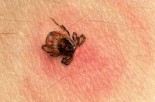Andrea was an active, happy, vivacious ten-year-old. A year later, Caesar had trouble catching her breath, debilitating migraines and battled consistent muscle aches. She was left undiagnosed for 26 years, and now has chronic Lyme disease.
Unfortunately, when it comes to treatment of Lyme disease, you have to get worse before you can get better.
It's important to understand the difference between acute Lyme disease and Lyme disease. Acute Lyme disease is when you have just gotten the bite and you either find the tick on you or see the rash.
Most people don't find the tick and don't notice the rash, which is why the disease can go undiagnosed for such an extensive period of time. If you do notice, you are one of the lucky ones.
If you are lucky, you should immediately go to see a "Lyme literate doctor" to treat the infection properly. What Andrea means by that is that the doctor understands how to aggressively treat the infection in its acute stage. You don't want someone who is going to hand you an antibiotic and say, "see ya in a couple weeks."
In this segment, Andrea, author of A Twist of Lyme, entrepreneur and mother, offers specific advice on Lyme disease as someone who has lived with it for majority of her life.
Things that parents should notice in their children if Lyme is suspect:
- An onset of migraines
- Missing more school than usual
- Lethargy or constantly tired
As you get older the symptoms to suspect are:
- Paranoia
- Depression
- Social and other phobias
- Seizure activity




 Andrea Caesar is an author, entrepreneur and single mother who suffers from chronic Lyme disease, a controversial life-long illness not recognized by some in the medical community. Despite her health problems, Caesar is the top ranked leader and sales consultant for Ava Anderson Non-Toxic, which specializes in personal care products free from toxic chemicals.
Andrea Caesar is an author, entrepreneur and single mother who suffers from chronic Lyme disease, a controversial life-long illness not recognized by some in the medical community. Despite her health problems, Caesar is the top ranked leader and sales consultant for Ava Anderson Non-Toxic, which specializes in personal care products free from toxic chemicals.